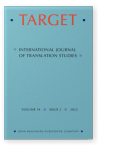Vol. 34:2 (2022) ► pp.219–250
Appearances
Character description as a network of signification in Russian translations of Jane Eyre
This article re-evaluates the theoretical import of networks of signification, one of Antoine Berman’s twelve deforming tendencies in translation. Taking Jane Eyre as a case study, the article considers character description as an example of a Bermanian network and traces the physical appearance of the novel’s characters across its six Russian translations. Character description represents a network that is traceable, depends on the reader’s ability to construct a visual mental image over the course of a narrative, has a tangible impact on characterisation, and remains relevant throughout a novel. It thus offers a concrete illustration of the relevance of networks of signification as a model for the systemic interpretative potential of translation variation. This analysis paves the way for further study of Bermanian networks and the ultimate integration of this concept in translation practice.
Article outline
- 1.Introduction
- 2.Character description and networks of signification
- 3.The literary portrait and the Russian Jane Eyre
- 4.Rochester’s physiognomy
- 5.Character and characterisation
- 6.Discussion
- 7.Conclusion
- Acknowledgements
- Notes
-
Jane Eyre in Russian (chronological order) -
References
